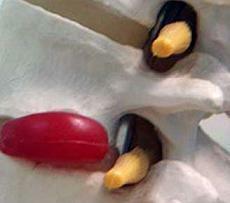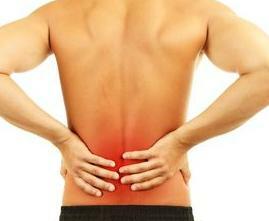 Intervertebral hernia is a degenerative disease of the intervertebral disc, characterized by a violation of its integrity and structure.
Intervertebral hernia is a degenerative disease of the intervertebral disc, characterized by a violation of its integrity and structure.
Our spine consists of 24 vertebrae, between which are located intervertebral discs. They represent the formation of a flexible outer ring (fibrous ring) and a pulpous core (a soft gelatinous substance filling the central part of the disc).
Intervertebral hernia of the lumbosacral spine, like many diseases of the spine, is associated with a violation of the integrity of these discs. The causes of such changes can be traumatic (back injury during a fall or impact, a sharp turn, lifting of gravity) or associated with a sedentary lifestyle and manifested in hypodynamia and overweight.
In this material, we will consider the main methods of treatment, as well as the symptoms that bother the person with this disease.
Why does an intervertebral hernia occur, and what is it?
This hernia appears as a result of intense or prolonged exposure to the spinal column. The main reason leading to the development of the intervertebral hernia in the lumbar region is osteochondrosis. Strictly speaking, to a large extent the symptoms of a hernia are symptoms of osteochondrosis.
Predisposing causesleading to this state:
- metabolic disease;
- various injuries, especially after an accident, after a sharp leap forward head;
- strong physical activity, sharp slopes, lifting of weights;
- curvature of the spine, hip dysplasia, scoliosis;
- increased body weight.
Concomitant factorsjust enough:
- weakness of the muscular apparatus;
- infectious diseases;
- sedentary lifestyle;
- bad habits;
- age changes;
- heredity;
- sedentary work.
All these causes lead to rapid aging, deterioration of cartilage and bone tissue, which can subsequently lead to the formation of an intervertebral hernia.
Stages of development
In the anatomical plan, the lower lumbar spine and the articulation of the 5th lumbar vertebra with the sacrum are most vulnerable. Therefore, most often the intervertebral hernia of the lumbosacral spine develops in the interval between the 4th and 5th lumbar vertebrae and between the 5th lumbar vertebra and the sacrum.
By the degree of changes in the intervertebral dischernias are classified as follows:
- Stage 1 - prolapse or lumbar protrusion. The disc is displaced to the minimum distance, which is no more than 2 mm. Outside the body of the spine, the nucleus does not come out.
- Stage 2 - the displacement of the edge disk does not exceed 1.5 cm. A pulpous nucleus is, as before, within the body of the spine.
- Stage 3 - extrusion. There is a displacement of the nucleus outside, beyond the vertebral bodies.
- Stage 4 - drooping outside the pulpous core, which is presented in the form of a drop. A fibrous ring can burst. The liquid substance flows out.
At the initial stages of the disease, short-term fast-passing pains in the back are possible. Symptoms of the intervertebral hernia of the lumbar region are manifested with the progression of pathology.
Types of lumbar hernia
Lumbar hernia can be divided into two types - L4-L5 and L5-S1. Each department of the spine is designated by the letter of the Latin alphabet, the lumbar division is marked with the letter L.
Hernia L4-L5 means that the infringement of the nerve root occurred between the 4th and 5th vertebrae of the lumbar spine. The sacral department is designated by the letter S, therefore, the hernia L5-S1 occurred between the 5 vertebra of the lumbar and 1 vertebra of the sacrum.
Symptoms
In the hernia of the lumbar spine may be noted:
- severe pain in the sacrum;
- weakness and a feeling of heaviness in the legs;
- stiffness of movements;
- when walking there is pain, giving back to the hips;
- there may be problems with the pelvic organs in severe cases;
- there is a pinched nerve and numbness of the legs in separate places.
All characteristic symptomatology can be divided into three main groups of syndromes: pain, vertebral, radicular.
Symptoms of the lumbar intervertebral hernia
 In the case of an intervertebral hernia in the lumbar region, the symptom most troubling for a person is the pain that slowly builds up as the disease progresses.
In the case of an intervertebral hernia in the lumbar region, the symptom most troubling for a person is the pain that slowly builds up as the disease progresses.
At first, the pain is dull, aching, localized in the place of lesion of the spine. It increases with stress, load, lifting of gravity or making sudden movements. At rest can completely disappear.
Then it spreads to the lumbar muscles, then to the lower limbs, it becomes sharp and shoots. Depending on which segment is damaged, it grabs the buttocks, hips, lower legs, heels and feet.
There are two stages in the manifestation of symptoms. At first, there is only a small pain in the lumbar region, which indicates that dystrophic changes in the intervertebral discs have begun. Under their influence in the vertebral discs, cracks are formed, their strength decreases. In the second stage, the pain is caused by tension and squeezing the rootlet. Direct contact of the hernia and spine causes a very strong pain syndrome.
Complications
One of the consequences with the intervertebral hernia in the lumbar spine is lumbulgia, that is, a lumbago in the lumbar region. With it there is a sharp pain, which is sharply increased even with the slightest movement. The patient may be in this condition for up to several weeks.
Treatment of intervertebral hernia of the lumbosacral spine
Intervertebral lumbar hernia to be treated both therapeutic and surgical. Everything depends on the specific situation, the stage of the development of the process, the presence of concomitant diseases and contraindications.
Therefore, when treating a hernia of the lumbosacral department, it is important not to miss the moment when it is still possible to help conservative ways and avoid surgery with all the ensuing consequences. With timely access to a specialist, you can stop the progression, to prevent possible complications.
Medication
Conservative treatment sets itself the task of arresting the pain syndrome in the acute period of the disease, and at its end - preventing relapses.
During this period of treatment it is recommended:
- Anti-inflammatory therapy. Non-steroidal anti-inflammatory drugs are prescribed: as ibuprofen, diclofenac, nise and naproxen can help cope with the pain, reduce the inflammatory swelling and at the time regain freedom of movement. Paravertebral and epidural blockades with glucocorticosteroid preparations have a good analgesic effect.
- Bed rest for several days. All movements are slow and confident. It is necessary to change the daily routine. Avoid movements that exacerbate pain: bending forward, lifting heavy things.
After the pain syndrome has receded, the number of medications used is decreasing, and the emphasis is on curative gymnastics, massages and physiotherapy procedures. The main goal is to improve the condition of the muscular corset and ligament apparatus.
Surgical treatment of lumbar hernia
Conservative methods are advisable to continue for 4-8 weeks. If during this time they were completely ineffective, you either need to change the tactics of treatment, or consider the question of surgical intervention.
Operations that perform with a lumbar hernia:
- Microdiscectomy- with this operation, part of the intervertebral disc is removed. In half the cases after this operation, relapse occurs.
- Laminectomy- surgery to remove bone processes that put pressure on the disk at the level of the affected area. However, this operation should be used with caution, since with it the spinal support function may be impaired.
- New methodology- Installation of titanium implants in the intervertebral space.
Surgery on a herniated intervertebral disc is the method of treatment that eliminates the cause itself. Indication for it is a serious neurological symptomatology associated with impaired pelvic organs and weakness and decreased sensitivity in the limbs.
Rehabilitation
Rehabilitation after an operation to remove the intervertebral hernia requires a serious approach. The patient should not sit for 3 months and should wear a corset, at first it worn constantly, then enough 3 hours a day. Another important method in rehabilitation is exercise therapy.
Prevention
The main measures aimed at the prevention of intervertebral sacral hernias:
- Contraindicated strong vertical and horizontal loads, even if your profession is associated with heavy physical labor.
- Keep track of weight - it is recommended to keep the body mass index no more than 30;
- The correct position of the body during sleep is to sleep better on a moderately hard bed, it is best to lie on your back so that the spine can relax.
- Active lifestyle, moderately loaded spine and strengthening muscular corset. If you have a sedentary job, take the time to practice sports or at least fitness.
- Correct, balanced nutrition and the rejection of addictions.
Compliance with these uncomplicated recommendations will keep the intervertebral disks intact.

How to choose probiotics for the intestine: a list of drugs.

Effective and inexpensive cough syrups for children and adults.

Modern non-steroidal anti-inflammatory drugs.

Review of tablets from the increased pressure of the new generation.
 Antiviral drugs are inexpensive and effective.
Antiviral drugs are inexpensive and effective.



